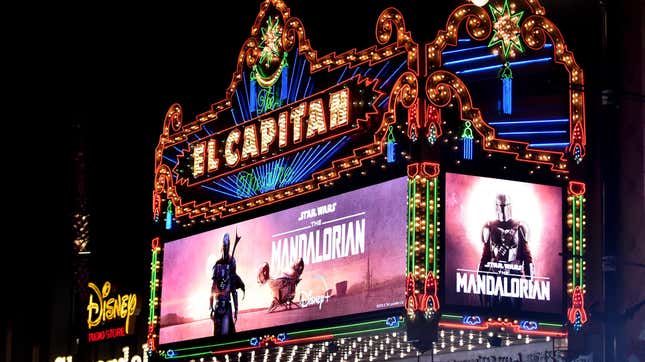
Disney’s deal to pay $4 billion for Lucasfilm, the home of the Star Wars franchise, in 2012, represented the entertainment giant’s fourth-largest acquisition. In marking May the 4th, the punny annual celebration of the Star Wars universe stemming from “May the force be with you,” it’s easy to see how the bet has paid off.
The intergalactic franchise, first created by George Lucas in the late 1970s, is an entertainment powerhouse that’s opened several doors for Disney in the last eleven years, including:
🍿 Between 2015 and 2019, Disney released five movies in the Star Wars franchise, four of which became massively popular. The 2018 Solo: A Star Wars Story bombed at the box office because of bad word-of-mouth and fierce competition at the movies. Anyway, three films in, Disney had already recuperated its investment. And with three new live-action Star Wars film on the way, the story is far from over.
💻 Streaming platform Disney+ struck a spin-off goldmine expanding the Star Wars story with live-action shows and animated series. The Mandalorian has played a significant role in boosting the platform’s subscriber count.
👕 Star Wars merchandise game is strong and Disney is cashing in on it.
🎢 Disney already dedicated a part of its theme park to Luke Skywalker, Princess Leia, Darth Vader, Yoda, and others. It’s sputtering a little—but that also means there’s more room for improvement, and for making more money.
One big number: Disney’s Lucasfilms purchase
$4.05 billion: How much Disney purchased Lucasfilm—home to legendary franchises Star Wars and Indiana Jones—for in October 2012. It’s a bit more than the $3.96 billion Disney paid for Marvel Entertainment, and its associated characters, for in 2009. The Star Wars franchise is the second-biggest one in the world, second to—you guessed it–Marvel.
Quotable: George Lucas on selling Star Wars to Disney
“I’ve always believed that Star Wars could live beyond me, and I thought it was important to set up the transition during my lifetime. I’m confident that with Lucasfilm under the leadership of Kathleen Kennedy, and having a new home within the Disney organization, Star Wars will certainly live on and flourish for many generations to come.”—Lucasfilm founder George Lucas in a statement in 2012.
Charted: Four out of five Disney-backed Star Wars movie were massive hits
Show of interest: The Mandalorian
The Mandalorian, whose first season released in November 2019, is arguably the biggest hit not just for Disney, but across streaming platforms.
The excitement around the adventures of the helmet-wearing bounty hunter and his cute apprentice, meme-worthy Grogu, aka “The Child” aka “Baby Yoda,” has built and lasted year after year. The successful second season spawned two spin-off series, The Book of Boba Fett, and the upcoming Ahsoka.
Disney+ has other blockbuster Star Wars titles up its sleeves, too. For instance: Obi-Wan Kenobi, which came out in mid-2022, clocked the biggest premiere for any Star Wars TV series, narrowly beating the second season of The Mandalorian. It excited fans because Ewan McGregor reprised his role as the titular character from the pre-Disney era. But while Obi-Wan Kenobi still pulls on a thread from the original Star Wars-verse, The Mandalorian perfectly straddles nostalgia and novelty, welcoming both age-old fans and newcomers with no previous context or knowledge of the franchise.
Where Star Wars makes its money
Star Wars merchandising has always gone far beyond just action figures and tote bags, well before Disney came into the fray.
On the publishing side, novels and comics have been released to drum up excitement for upcoming films. On the more unabashed merchandise front, there’s shower heads, dog costumes, and barbecue utensils. And if it weren’t a child-friendly brand, there may have been “condoms and sex toys” thrown in the mix too, according to Charles Lippincott, the marketing genius who was responsible for promoting and licensing the first part of the Star Wars trilogy.
Already in 2015, with the first Disney-Star Wars release, Disney was poised to make $5-$7 billion in merchandising revenue. That figure likely only grew over time.
Star Wars theme park trial and error
At Disney’s Hollywood Studios, there’s an immersive world called Star Wars: Galaxy’s Edge filled with rides and retail.
One attraction, the Star Wars: Galactic Starcruiser —dubbed “the Star Wars hotel”—initially generated a lot of buzz, but the $5,000-for-two price tag for two nights turned many people off. The 100-room attraction has struggled to sell out. Disney started cutting back on the frequency of voyages, and running sales on ticket prices for select members and cardholders. It even started paying people to come stay as part of a focus group study to figure out what’s wrong.
There are wrinkles to iron out, but as the company builds and rebuilds a fanbase for the Star Wars franchise, there’s immense amusement park entertainment potential to tap into. Especially as Disney gears up to build a fifth theme park in Florida, announced more than 25 years after the fourth one, Animal Kingdom, opened in 1988.
Related stories
👀 Disney is leaning on layoffs to save streaming
🤖 The filmmaking technology behind “The Mandalorian” is straight out of the Star Wars universe